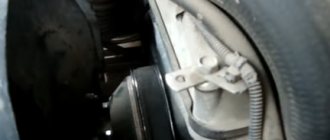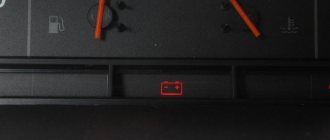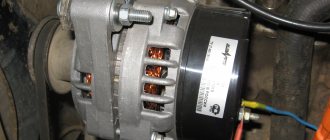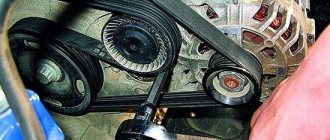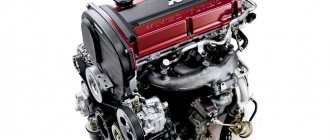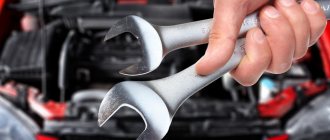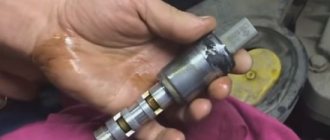Design features of generator belts
The belt, as a key element in transmitting torque from the shaft to the generator, has a multilayer structure that ensures long-term operation under high mechanical loads and large temperature differences. The main components are the outer covering, the compression layer, and the fiber traction layer.
The generator belt can have different designs. In different models of passenger cars there are:
- constant mesh timing belts, which potentially provide the greatest value of transmitted torque;
- ripple-type belts with several longitudinal working ribs, the introduction of which ensures increased operational reliability;
- V-belts with a trapezoidal cross-section and lateral working surfaces (the V-shaped shape ensures an increase in the adhesion force with the mechanism pulleys).
Each of these belts interacts only with its own type of pulley.
Chernolev › Blog › How to check the condition of a car’s drive belt yourself
The functional task of drive belts is to transmit torque from the car engine to other operating units and mechanisms.
To prevent possible failures of various systems, it is periodically necessary to perform procedures such as adjusting the tension of the drive belt or replacing it. This article will tell you how and with what frequency to do this. The frequency of checking drive belts depends on how actively the vehicle is used. On average, one belt is enough for 25 thousand hours of continuous operation, but not necessarily. This will depend on factors such as:
operating conditions (ingress of oil, dirt, chemically active elements, external mechanical influence, temperature changes); the condition of the drive pulleys and tension rollers, the deformation of which leads to wear of the belts; incorrect installation (excessive or insufficient tension); storage conditions before installation on the car (the belt is made of materials that are subject to natural aging, it can wear out even when lying in a store warehouse). belt quality (service life can vary greatly depending on the manufacturer and materials used). On average, it is worth checking the belt approximately every 25 thousand kilometers or once every six months.
How to check drive belt tension
In order to check the belt tension, you first need to find it. As a rule, this is quite simple to do; all you need to do is shine a flashlight under the hood. Having found the belt, you should press the area between two adjacent rollers with your thumb. The following deflection indicators are considered normal:
When the length of the section between the rollers is from 150 to 300 mm, the belt should bend by approximately 6 mm; When the length of the section between the rollers is from 300 to 450 mm, a deviation of up to 12 mm is permissible. If you deviate from these standards, the belt must be tightened. For this purpose, special tension rollers are provided in the design of the belt drive. Doing this yourself is quite simple; the only problem may be the lack of engine compartment space in some car models. Sometimes, in order to get to the tension roller bolts with a wrench, you have to disassemble half the car. In this case, it is better to save time and nerves by contacting a car service.
Another characteristic sign of insufficient drive belt tension is a characteristic sharp whistle from under the hood. This sound appears due to the belt slipping along the pulley when the drive speeds up.
Signs of belt wear and replacement
When inspecting the drive belt, you may notice the following signs of high wear:
the inner layers of rubber became visible on the side walls of the belt; surface abrasion; cracks; structure delamination; surface polishing; damage to the reinforcement layer. If at least one of these signs is detected, it is better to replace it without waiting for a break on the go. Replacing a belt with your own hands is as easy as tightening it. But perhaps the main problem will be the same. If it is difficult to reach the belt and there is no confidence in your own abilities, then it is better to seek help from professionals.
Source
Tension control
Normal operation of a belt drive requires no slippage and is ensured by adequate tension. Due to the difficulties of directly measuring it without specialized measuring instruments, control is performed indirectly.
The tension is considered sufficient if the amount of deflection when pressing strongly on the belt of a new ribbed or V-belt in the area of its longest free part between two pulleys does not exceed 2 mm. Over time, due to fatigue phenomena, an increase in deflection of up to 5 mm is permissible. When checking, a ruler is applied to the plane of the belt, and pressure can be created with the leg of a caliper, which has a scale.
In the case of a toothed belt with constant mesh, the deflection is replaced by a lateral rotation: the deflection angle of the working surface plane should not exceed 90 degrees.
Regardless of the version, it is recommended to check the tension on a new car and check it every 20 - 30 thousand kilometers.
Signs of wear or when to change the belt
It can be seen that the belt on the right is worn, cracked and needs to be replaced.
The first sign of a weakened car alternator belt is a characteristic whistle from under the hood. It appears at medium or high engine load, when the headlights and heater are turned on at the same time, and intensifies when the gas is added. Initially, nothing catastrophic happens, except for a decrease in the power removed from the generator. The degree of its decline gradually increases over time.
An indirect sign of a loose belt, even without a characteristic whistle, can be a poor battery charge, although it can be caused by other reasons.
It is much more serious if the belt begins to “whistle” at low speeds and with minimal load on the on-board network.
Video: The alternator belt whistles, breaks, falls off - WHAT TO DO? Just something complicated
When you need to replace the alternator belt: signs of wear, we do it ourselves
Good day to all! In our material today, I propose to discuss such a topic as replacing the alternator belt.
If there is severe wear and tear, the generator may simply stop working because its drive belt has failed. Do not forget that in some cases the fault lies not in the wear of the belt itself, but in the components of the entire assembly. For example, motorists are often faced with the need to replace the tensioner pulley bearing. But some cars provide for the use of alternator belts without a tensioner.
In practice, changing the node is not difficult. It is much more important to notice problems in a timely manner so that a breakdown does not take you by surprise, at the most inopportune moment.
Restoring car alternator belt tension
The belt tension is restored to the standard value using the corresponding standard engine mechanism. The need for this is due to the fact that a loosely tensioned belt is subject to increased wear and is no longer able to transmit maximum power to the generator. The belt is not dismantled in this case.
The belt tension mechanism is implemented on the basis of a tension bolt or in the form of an eccentric. When working with them you will need a wrench. The bolt or eccentric rotates in a direction that corresponds to an increase in the degree of tension. The bolt is never completely unscrewed, and working with an eccentric is advantageous in that it requires no more than half a turn, albeit with great effort.
If, after restoring normal tension, the whistle does not stop, then the cause of the malfunction is a malfunction of one of the generator bearings.
The process of dismantling the old and installing a new belt
- Before starting work, place the car on a level surface, tighten the parking brake, and engage first gear. Be sure to turn off the ignition and remove the negative terminal of the battery, which protects against the risk of a short circuit.
- Consider the installation location of the tensioning mechanism on the engine. If it is located at the bottom, work will be required from the inspection hole.
- Release the belt tension. To do this, rotate the adjusting bolt or eccentric head in the desired direction. On some models, the belt is loosened by unscrewing the generator fasteners, which are additionally tilted to the side.
- After this, remove the old belt and check its serviceability.
- Installation of a new belt begins with the shaft pulley. Only then is it put on the generator pulley and, lastly, on the pump pulley.
- The final stages are restoring the standard tension, connecting the battery and checking the functionality of the mechanism.
These procedures, if you have a certain skill, will take a quarter of an hour.
Video: Replacing the alternator belt on a Priora with power steering or air conditioning
How to tension, tighten or loosen a drive belt
If the cause of the whistle, squeal or squeak is actually a belt that has become loose and as a result slips on the pulleys, and if the belt does not have any signs of wear or damage, then to remove the extraneous sound you just need to tighten the belt.
Using the same example of a generator belt, this is done using a special adjusting bolt (on modern cars) or using an adjusting bar (on older cars).
For example, to tighten the alternator belt on a modern car, you need to do the following:
— Slightly loosen the generator mounting bolts (upper and lower fastenings).
— Turn the adjusting bolt clockwise, thereby moving the generator away from the engine block and immediately check the belt tension level.
— Then, tighten the nuts of the generator fastening elements.
Please note that in some vehicle systems, the process of tensioning the drive belts is too labor-intensive and requires the use of special tools.
But for its (their) initial tension a special tool is needed.
In many cars, special belt tension rollers are also used for this, which saves drivers from constantly tightening these belts. The only drawback of this design, as a rule, is that when replacing drive belts, it is also necessary to change the tension roller itself, since its reuse together with a new belt is impossible.
